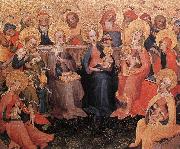Wholesale Oil Painting No Minimum |
|||||||||||
|
|
|||||||||||

|
|||||||||||
|
|
|
||||||||
|
|
||||||||
The Holy Kinship
The Holy Kinship Painting ID:: 65061 |
1410-40 Tempera on oak, 85,3 x 95 cm Wallraf-Richartz Museum, Cologne The depiction of the extended Holy Family ('Holy Kinship') on the central panel of the triptych introduces one of the most popular new themes for paintings at the beginning of the 15th century. All Christ's relatives are gathered together, following a description in the Golden Legend of 1263-73 by Jacopo da Voragine. , UNKNOWN MASTER, German , The Holy Kinship , 1401-1450 , German , painting , religious 1410-40 Tempera on oak, 85,3 x 95 cm Wallraf-Richartz Museum, Cologne The depiction of the extended Holy Family ('Holy Kinship') on the central panel of the triptych introduces one of the most popular new themes for paintings at the beginning of the 15th century. All Christ's relatives are gathered together, following a description in the Golden Legend of 1263-73 by Jacopo da Voragine. , UNKNOWN MASTER, German , The Holy Kinship , 1401-1450 , German , painting , religious |
|||||||
|
|
||||||||
|
Geertgen Tot Sint Jans Netherlandish Northern Renaissance Painter, ca.1460-1490 Geertgen tot Sint Jans is also known as Geertgen van Haarlem, Gerrit van Haarlem, or Gerrit Gerritsz.[citation needed] Alternative spellings of his first name are Gheertgen, Geerrit, and Gheerrit, where G(h)eertgen is the diminutive form of G(h)eerrit. Presumably, he was born in Leiden, then in the Burgundian Netherlands in the Holy Roman Empire, around the year 1465. The assignment of Leiden as his birth place is traceable to a 17th century print by Jacob van Matham. There is no known archival evidence for this claim by Jacob van Matham. The modern acceptance of Leiden as Geertgen's birth place is roughly traceable to Johann Kessler's dissertation of 1930. Probably, Geertgen was a pupil of Albert van Ouwater, who was one of the first oil painters in the northern Low Countries. Both painters lived in the city of Haarlem. Geertgen was attached to the monastery of the Knights of Saint John, for whom he painted an altarpiece. Although Geertgen was not a member of the Order of Saint John, his last name "tot Sint Jans" was derived from the order's name and means "unto Saint John". Geertgen died in Haarlem, then the Habsburg Netherlands in the Holy Roman Empire, around the year 1495, when he was approximately 28 years old. He was buried in the monastery of the Knights of Saint John. Modern scholars have attempted to calculate the artist's death date with the information from The Painting-Book (Middle Dutch: Het Schilder-Boeck) by Karel van Mander, published in 1604. There are some archival traces that suggest he may in fact have lived into the 16th century. The Holy Kinship between 1485(1485) and 1495(1495) Medium oil on panel cjr |
||||||||
|
|
||||||||
|
Prev Next
|
||||||||
|
|
||||||||
|
Related Paintings to Geertgen Tot Sint Jans :. |
||||||||
|
|
||||||||
|
CONTACT US |

